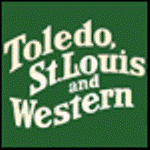This railway began in 1874 as the Toledo and Maumee Railroad, a 7-mile long
narrow gauge line built along the Miami and Erie Canal in Toledo. In 1879, it
consolidated with four other railroads, becoming the Toledo, Delphos and
Burlington Railroad. It reached East Saint Louis, MO, in 1883. Shorty after, the
company collapsed, and the lines were broken up and sold to different railroads.
A short time later, the Toledo-East Saint Louis line became the Toledo, Saint
Louis and Kansas City Railroad, adopting the "Cloverleaf" as its emblem. The
line was converted to standard gauge in the late 1880s. By 1893, the company went
into bankruptcy, and emerged as the Toledo, Saint Louis and Western Railroad.
The company lasted until 1922, when it was purchased by the Nickel Plate Road
(NKP). It subsequently became the "Cloverleaf Division," and finally provided
the connection to Saint Louis for the NKP, which was the original intent upon its
formation.
In 1964, the NKP merged with the Norfolk & Western (NW). In the early 1970s, a
derailment near Continental spelled doom for this line; rail was pulled up from
Grand Rapids to Douglas in 1975, and from Douglas to Craigville, Indiana, in 1998.
(This portion was sold to a shortline railroad in the late 1980s, but service was
eventually discontinued by 1998.)
A 15-mile segment of the line from Waterville, south of Toledo, to Grand Rapids
was saved, and is still in use by a volunteer railroad, the Toledo, Lake Erie, &
Western. Otherwise, most of the ROW has been obliterated by agriculture.
Ironically, the Public Utilities Commission of Ohio (PUCO) still lists the
portion from Continental to the Ohio/Indiana state line as active, though no
trackage remains on this segment. (Click photo below to view larger)
It subsequently became the "Cloverleaf Division," and finally provided
the connection to Saint Louis for the NKP, which was the original intent upon its
formation.
In 1964, the NKP merged with the Norfolk & Western (NW). In the early 1970s, a
derailment near Continental spelled doom for this line; rail was pulled up from
Grand Rapids to Douglas in 1975, and from Douglas to Craigville, Indiana, in 1998.
(This portion was sold to a shortline railroad in the late 1980s, but service was
eventually discontinued by 1998.)
A 15-mile segment of the line from Waterville, south of Toledo, to Grand Rapids
was saved, and is still in use by a volunteer railroad, the Toledo, Lake Erie, &
Western. Otherwise, most of the ROW has been obliterated by agriculture.
Ironically, the Public Utilities Commission of Ohio (PUCO) still lists the
portion from Continental to the Ohio/Indiana state line as active, though no
trackage remains on this segment. (Click photo below to view larger)
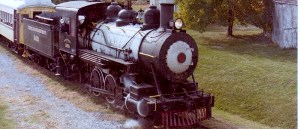
Toledo, Lake Erie, & Western steam engine at Grand Rapids, Ohio.
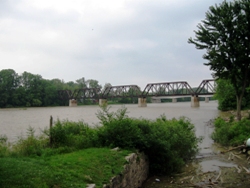 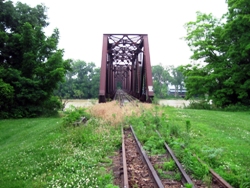
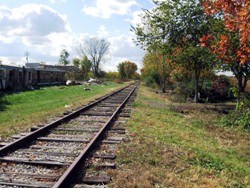
Old Toledo, Lake Erie, & Western bridge and track views near Waterville, Ohio.
A shortline, the Wabash Central Railroad, operates the tracks beyond this
line west from Craigville to Van Buren |
